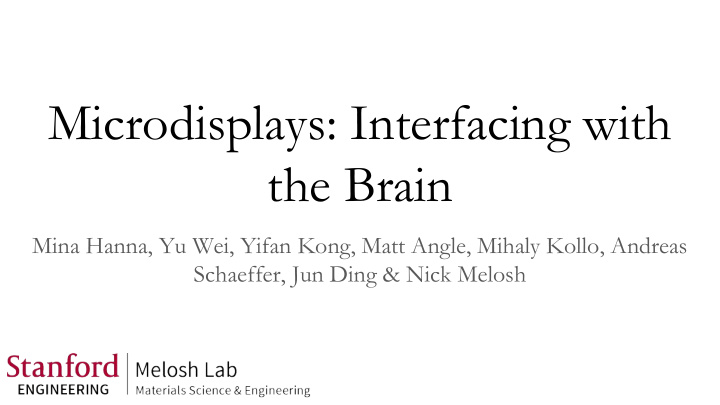



Microdisplays: Interfacing with the Brain Mina Hanna, Yu Wei, Yifan Kong, Matt Angle, Mihaly Kollo, Andreas Schaeffer, Jun Ding & Nick Melosh
Deep Brain Stimulation FDA-approved application Affected Persons in NA Essential Tremor 7,000,000 OCD 5,000,000 Parkinson’s Disease 1,000,000 Tourette Syndrome 300,000 Target = STN 2
Deep Brain Stimulation - Cont. Current Market Size: $800M (QiG 2016 Estimate, all neurostimulation $4.5B) 2020 Projection: $3.21B (Transparency Market Research 2020 Estimate) The Market is large and growing quickly. 3
The Selectivity Problem Today, DBS lacks the resolution to target therapeutic pathways without also activating other areas. This causes speech defects, among other side-effects. poor spatial selectivity activates many brain areas Diameter 1.27 mm 4
More Channels, More Precision In 2014 Medtronic bought Sapiens DBS for $200M for a their DBS system that uses a 32-40 electrode stimulator. Clinical trials have shown improved targeting over traditional DBS. improved spatial selectivity ….but still activates >10,000 neurons in bulk The STN contains 560,000 neurons 5
Current Research Technologies are Ill-Suited... Blackrock Microsystems - Utah Array 2 mm 50 um R. Tomer et al. Nat. Protocol, 2014 6
Current Research Technologies are Ill-Suited… - Cont. High Density ‘Michigan Style’ Probes 50 um Sholvin et al. IEEE, 2015 50 um R. Tomer et al. Nat. Protocol, 2014 7
Current Research Technologies are Ill-Suited… - Cont. 66,000 neurons 200 um Inhibitory interneurons in a cortical column form hot zones of inhibition in layers 2 and 5A, Meyers et al. 2011 8
Moore’s Law & Neurobiology 9 Adapted from Stevenson and Kording, 2011
Moore’s Law & Neurobiology 10 Adapted from Stevenson and Kording, 2011
Moore’s Law & Neurobiology 11 Adapted from Stevenson and Kording, 2011
What we need? Well insulated High Aspect Ratio (um diameter for millimeter - centimeter length) Can be densely packed Can be produced at Scale (in excess of 10,000 individual channels) And can sample densely from a three-dimensional area 12
Microwire bundles for DBS US patent application no. 14/937,740 thousands of wires each smaller than a human hair Microwire bundles will allow cellular and circuit-level targeting. 13
Neural Recordings Work done by Andreas Schaefer, Crick 14
We achieve this massive parallelism by using proven, scalable components The probes can be easily produced at scale using simple manufacturing techniques, and with much greater electrode density, compared to existing technology. CMOS sensor technology is widely available and has benefited from billions of dollars and hundreds of person- years worth of development. 15
Using Microdisplays to Individually Control Microwires 500 um 10 um 16
Using Microdisplays to Individually Control Microwires Fiber-based brain machine interface (BMI) technology to provide ultra-high resolution simulation and recording 500 um 10 um Highest resolution & highest number of independent electrodes ever developed for BMI 17
The Need for Precision Conventional 125 um electrode stimulates a large field Single microelectrode stimulates only a few cells With Jun Ding, Stanford Neurosurgery, Dr. Yu Wei Wu 18
Stimulation of Individual Neurons and/or Axons High spatial precision, activating only a few neuron or axon fibers Creating different spatial and temporal patterns, and allow adjusting stimulation amplitude and frequency between stimulation leads With Jun Ding, Stanford Neurosurgery, Dr. Yu Wei Wu 19
Stimulation of Individual Neurons and/or Axons Will be the first demonstration of large stimulation devices that are capable of modulating the activity of hundreds to tens of thousands with high spatial precision May allow precise parsing of components is responsible for therapeutic effects With Jun Ding, Stanford Neurosurgery, Dr. Yu Wei Wu 20
Acknowledgements Professor Nicholas Melosh Dr. Matt Angle Professor Jun Ding Professor Andreas Schaeffer Materials Science & Neuroscientist Neurosurgery Neurophysiology Engineering Paradromics Inc. Stanford University Crick Institute Stanford University 21
Acknowledgements 22
Recommend
More recommend